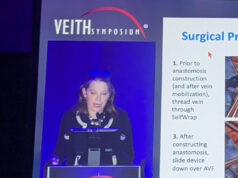
When it comes to treating steal syndrome, the extent to which the dialysis patient in question is displaying symptoms—as well as their flow rate and the location of their anastomosis—should all be taken into consideration. This concept was presented by vascular surgeon Stephen Hohmann (Texas Vascular Associates, Dallas, USA) at the Vascular Access Society of the Americas 2021 Spring Virtual Conference (VASA, 21–22 May, online).
In addition to discussing potential procedures designed to manage steal syndrome, which is sometimes referred to as dialysis access steal syndrome (DASS), Hohmann outlined a flow chart-style set of frameworks he uses—firstly to determine whether or not treatment is actually necessary, and then to home in on the most appropriate solution between proximalisation, distalisation, ligation, or an alternative approach. He also used a 50-year-old female patient with a left-arm arteriovenous (AV) graft experiencing “pretty significant steal”, gangrene at the tip of her index finger, and a relatively low flow rate, as a case study throughout his presentation.
“In terms of what you should do—it really does depend,” Hohmann said. “Is it a high-flow access, or a low-flow access? Is it a highly symptomatic patient, or not so much? If we take the patient we started off with—they are female, they have very significant steal because they have gangrene at the tip of their finger, their anastomosis is brachial, and it is a low-flow access. So, the best choice here would be proximalisation—hooking it [the anastomosis] up to an axillary artery in order to prevent that steal from happening, and healing her finger up with a minor amputation.”
The complex issue of steal
Hohmann stated that steal syndrome occurs in about 1–3% of distal radial artery AV fistulas and 10–20% of distal brachial artery AV fistulas—and these rates are significantly higher in the femoral location. Despite this, he also put forward the idea that “most people with some sort of access have steal—it is just whether it is symptomatic or not”, as well as urging the use of “conservative approaches” to manage the condition in the earlier, less severe stages, and stated that he would only initiate a procedure if the patient’s steal is symptomatic.
Hohmann cited peripheral arterial disease (PAD)—or any stenosis proximal to the anastomosis—as well as high AV access flow, and poor collateral blood supply, as potential risk factors associated with steal syndrome too. In addition, he informed the VASA 2021 audience that patients who are female, over 60 years of age, diabetic, have had previous steal or prior access surgeries in the affected limb, or have had their distal brachial arteries used as an anastomosis site, are all at a greater risk of developing steal syndrome. “When we talk about steal, I think all of us have encountered one steal patient who has consumed the dollars of 50 other patients,” Hohmann added, also citing the “sad outcome” of amputation as one of the reasons for this.
Regarding blood flow direction, one of the key physiologic changes associated with access creation, Hohmann asserted that steal that is distal to the AV access is more complex as the flow of blood may be moving forward (antegrade), in either direction (biphasic) or backwards (retrograde)—with the latter being the most common of the three—while the flow in steal proximal to the AV access is always antegrade. “Even if someone has retrograde flow, they may not be symptomatic, and they could still have excellent pressures,” he added. “So, I would say, of all the issues with dialysis access including infection, thrombotic and non-thrombotic issues, this is really one of the more enigmatic ones in terms of why it happens.”
Treatment options for steal syndrome
As well as touching upon the various ways physicians can screen and diagnose steal syndrome, from patient history and physical examinations to ultrasound scans—specifically for assessing flow volumes—and measuring finger pressures, Hohmann claimed that treatment options range from observation to ligation, with “a lot in between”.
Detailing these treatment options further, he first suggested that the best way to treat a radiocephalic AV fistula is via distal radial artery ligation, due to the fact it can provide “excellent relief” from retrograde flow, before asserting that, in general, distal revascularisation interval ligation (DRIL) is “going out of style”—referencing vein harvesting complications and infection as potential issues associated with the procedure. Hohmann added that, while DRIL can provide good symptom relief and bypass patency, “most people are not doing this” nowadays, referencing audience polls at previous industry events to support this statement.
Hohmann stated following this that proximal arterial inflow (PAI), which involves moving the anastomosis to a higher position in the arm and increasing the length of the circuit, is “definitely the prom king or queen” of open revision right now, having gained favour among physicians due to the fact it avoids ligation of the patient’s native tubes. He also added that revision using distal inflow (RUDI) is successful in about 90% of cases—and avoids native artery ligation too—but may come at the cost of an elevated risk of thrombosis.
Hohmann told VASA attendees that ligation can reliably relieve the symptoms of ischaemic monomelic neuropathy (IMN), but still has less of a role to play in treating steal syndrome than proximalisation or distalisation because they are safe and generally produce good outcomes, while banding—either via open surgery or an endovascular approach, depending on the specific situation—is “great” for high-flow grafts. In concluding his presentation, Hohmann added that preventative measures, such as creating a proximal artery anastomosis instead of a brachial artery anastomosis, should also be taken into consideration too.











